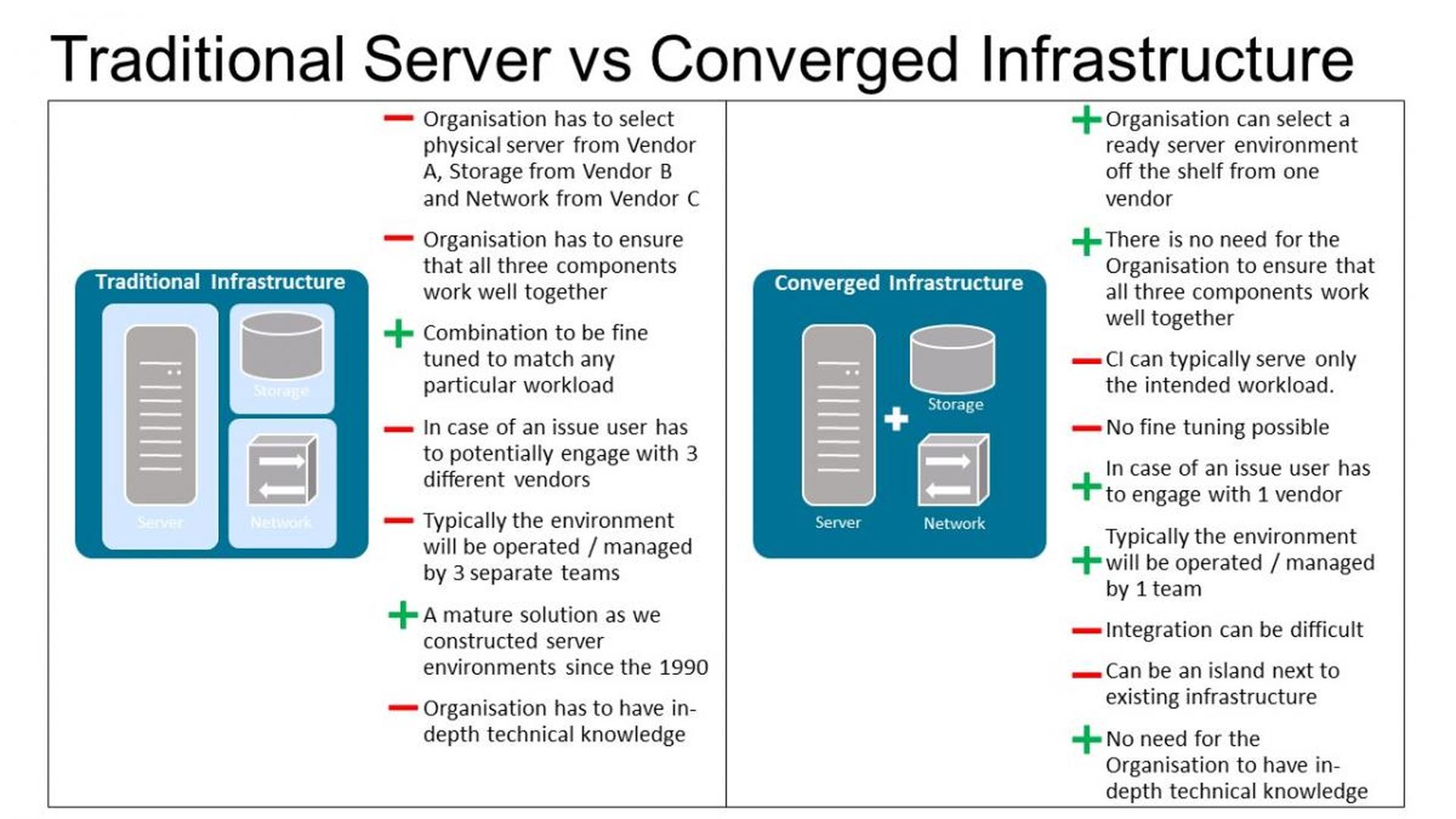Today there are three ways to build a server environment :
In principle for converged infrastructure there are two main approaches used today:
Converged vs. Hyperconverged Infrastructure (CI vs. HCI)
The difference between CI and HCI can also be explained as follows: When you see a CI rack you can clearly identify the server, the switch and the storage bay; in a HCI you cannot clearly identify these any more – all 3 key components are “hyperconverged”.
Both follow a similar business case – pre-packaged and pre-configured server environments that are comes “in a box”. HCI builds on CI as it comes with further data centre related tools and capabilities : backup, data snapshot, data replication, data deduplications, data tiering, inline compression, WAN optimizations etc. Some HCI products also make use of new developments like software based storage as well as software based networking.
Another difference between CI and HCI is the fact that with CI each component is discrete and each can be used independently – so the compute component in a CISCO UCS can be used to run a Server or the storage can be used as a simple file storage. For a HCI that is not the case – all components are hyperconverged so each cannot be split.
CI Detail
Compared with the traditional way of constructing a server environment (a) a CI can accelerate the provisioning of server capabilities as it comes pre-configured and pre-tested. Vendors, like Cisco, HP, NetApp of VCE ship pre-selected, pre-constructed and tested compute, storage and network units, ensuring that all three work well together.
CI Advantages
The advantage is clear – you can buy a server environment “in a box” and simply install the rack and within a short period of time a server can be provisioned. Typically CI come in different sizes to match the required workload and when selecting the CI unit you have to simply find the one that matches your workload. For instance to run 100 virtual machines for server workloads, or up to 250 virtual machines for virtual desktop infrastructure (VDI) workloads.
CI solutions are natural progression from traditional server environment where compute, storage and network were separate silo’s, designed, procured, implemented and operated by separate groups – the storage team, the server team and the network team. The concept of CI solutions combines these infrastructure silo’s as a pre-engineered and tested solution.
CI Disadvantages
But there are also disadvantages with CI solutions. As all parts are pre-selected and pre-configured you have to apply the CI as the vendor intended. It is a bit like implementing a COTS (commercial off the shelf solution) where the user has to follow the business process the vendor defined rather than using a Custom build application where the user can code his unique business process. The same principle applies to the units as well. Because each unit has been selected, configured and tested by the vendor you do not have an option to choose a different unit. In addition there are no ability to apply granular updates / patches or “tweak” the CI solution – you have to follow the vendor path.

CI and Cloud
CI and cloud, or better private cloud are closely linked. A private cloud is a type of computing that delivers similar capabilities as a public cloud – self-service, auto-scaling and orchestration – however build within an organizations own premises and by using dedicated and proprietary technology. To build a private cloud the organization has to deploy server capabilities and as outlined above there are three different options today : a) DIY, b) CI or c) HCI.
CI Benefits
Organisation that have deployed CI solutions cite a number of key benefits :
- More efficient provisioning of resources
- Easier to hold one vendor accountable than 3+
- More agility in responding to new demands
- Lower cost by reducing headcount of IT teams
- Faster reallocation of resources during operation
- Reduced implementation time
CI Implementation
Implementing a CI solution is not much different to implementing a technology component. It needs proper planning, designing, testing and documenting. One key aspects that sometimes gets overlooked is training as well as the overall system management integration. When reading CI related material it might seem that operation as well as system management integration is simple. However, it is seldom that simple. In particular when implementing a CI next to an existing mixed server environments. Even if the CI is “only” used to host virtual server there is still the need for HA, backup, archiving, restore, deployment, monitoring and maintenance.
CI Vendors
There are a large number of vendors who sell CI based solutions – IBM, Fujitsu, Dell, Lenovo, NetApp, Cisco, Oracle, EMC to name a few. As with any infrastructure project a business case is needed to establish a clear case for change. Also there are many different options and a large number of vendors available. Organizations that are planning to deploy a CI solution should go through a proper procurement process incl POC and vendor selection. Knowing what the target workload will look like is key in selecting the right product. Deciding which CI to buy is a bit like buying a vehicle – you can build your own or go to a dealer to buy one “off the shelf”. In either case you have to know what the car is for – offroad, only highway, inner city or ploughing a field and what commercial aspects you need to consider.
Summary
Organizations that deployed a CI solution typically benefit from better customer service (there is one Vendor to deal rather with 3), improved availability and better agility and speed to value.
However, CI is not quite mainstream and there are many different options available which in turn can increase complexity. In addition CI solution is not a “silver bullet” that performs in all scenarios and CI solutions are not fully “plug and play”– to successfully implement and operate a CI solution to gain from the CI value proposition, an organization has to have a full business case, has to execute a solid selection process and focus on system and tool integration as well as staff training during plan, design and implementation. Also, a CI solution is still physical hardware and all hardware specific implementation and operational consideration do apply.

Gunnar Menzel is VP and chief architect officer for Capgemini’s Cloud Infrastructure Business. Read more Capgemini blogs here.




